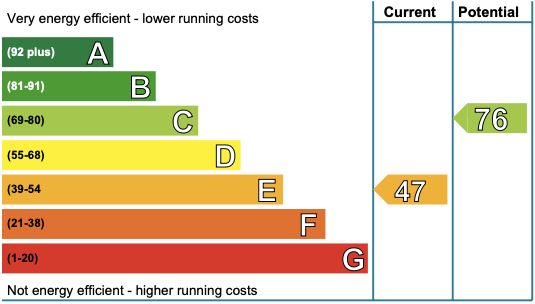Home Energy Performance Explained

Some believe that Energy Performance Certificates (EPCs) are quite a recent thing as a result of rising energy costs. They have been around since 2008 and are an integral part of property valuations. House builders more frequently use the energy efficiency of new homes as a selling point now. You will also find energy performance on household appliances.
What is the purpose of Energy Performance Certificates?
The purpose is to tell you how energy efficient a property is today and if there are improvements you could make, how more energy efficient it could be in the future. The image below is from a property my eldest son purchased early in 2021.

The chart provides a range from A to G. The higher the rating the more energy efficient the property is and the less it will cost to run. In this case, the rating is quite low at E.
It also tells you the potential rating if the cost-effective measures in the report are implemented. Doing these would increase the rating to a C.
As part of the report the valuer should provide the detail of what could be improved at the property, the cost of those improvements and the benefits in terms of reduced energy costs.
In addition, the report will also provide an impact assessment on the environment. This is based on the carbon dioxide emissions the property emits. Again, the more energy efficient the property is the fewer emissions.
An EPC is valid for 10 years.
Considering the recommended improvements
Within the EPC there will be recommendations you can take. These need to be balanced with the cost of doing them and the energy savings that could be made. In this report, the following has been suggested.

There is potential for savings to Heating, Hot water and Lighting of £2,168 over 3 years by following the recommendations. The report should tell you what could be done and should provide an indicative cost of completing those recommendations in order to achieve potential savings.

We can see that spending up to £1,890 today on loft insulation, cavity wall insulation and low-energy lighting leads to savings of £2,168 over 3 years and of course beyond. That seems like a worthy undertaking.
Of course, these are all estimates. You may save more or it may be less. There are no guarantees. That said, energy efficiency is important, especially in current times when energy costs are so high for us all.
Sometimes the changes needed are obvious
Whilst my sons property isn't really that bad and could be improved with some reasonably small changes there are a lot of issues properties can have that can make significant changes to energy use if fixed. Over the years I have visited hundreds of properties and some of the fixes are simple and obvious. Here are some common examples of what I have seen.
- Gaps around windows and doors
- Poor floor coverings
- Poor loft insulation
- Inefficient heating systems
If you have gaps around your windows and doors or they don't seal properly when closed then you will lose heat through them. Thin floor covering with no underlay can be an issue if there is a void under the floor where cold air can come in and warm air can escape. For the most part, we know about these issues as there is that "draught" coming from somewhere.
Heating systems that are not properly bled or are not appropriate for the size of the house can mean having to run the system far longer to build warmth.
The idea of being energy efficient is a simple one especially when it comes to heat. The less opportunity there is for heat to be lost through the structure means less requirement to have the heating on as it will stay warmer for longer. My own home is rated B, so pretty good but, my wife likes to "air the house" by having windows open for 8 hours each day (even in the winter). Great, but not for energy efficiency!
Sometimes you can't improve
Depending on the age and style of the property there may be no recommendations to make. I have seen many properties rated at the lowest of G and even if there are some opportunities it still won't move the rating higher than G.
New homes have to be energy efficient
There are new legal requirements for house builders to pay more attention to energy efficiency. There is proof to show new homes are saving their owners on average around £2,500 each year vs an older less efficient one.
84% of new homes in the UK had an EPC rating of A or B. This is due to them having more efficient heating systems, better insulation, more economic appliances and in some cases solar energy collection.
The government has also announced a ban on gas boilers from 2025. That is only for new homes, if you have a gas boiler today you will be able to continue using it and replace it in years to come. It is expected that new homes will use renewable heating technology such as a heat pump. But it is dubious that is realistic at this stage.
Summary
Its good to have the benefit of an EPC to tell you how efficient a property is and what improvements can be made. That said, we know our properties, where the draughts are or the most common improvements such as insulation are missing. You don't need a report to point them out in most cases.
The older our homes are the less efficient they will be. Try to ensure the most common and cost-effective changes are made. If you struggle to reduce the use of gas to heat the home, try and replace all your lighting with energy-efficient bulbs. When you replace an appliance, pay particular attention to getting one that is more efficient than the one you have. These changes could at least reduce electricity usage to offset the higher gas usage. It is often the small changes that lead to longer-term impacts.
Lee Wisener, CeMAP, CeRER, CeFAP
Having worked in the mortgage industry for over 20 years I have always wanted to build a website dedicated to the subject. Also being a geek when it comes to the internet all I needed was time and I could both build the site from scratch and fill it with content. This is it!

<< Newer Post
Inflation explainedOlder Post >>
Stamp Duty Explained